新编大学基础英语综合教程第一册教案
全新版大学英语综合教程第一册教案-Unit1
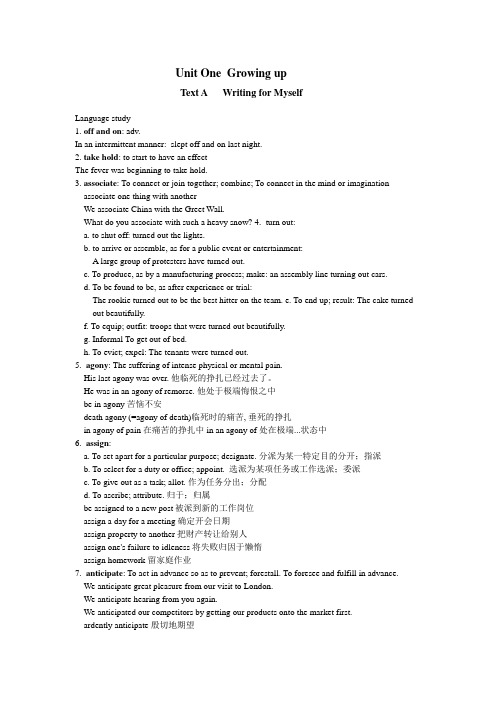
Unit One Growing upText A Writing for MyselfLanguage study1. off and on: adv.In an intermittent manner: slept off and on last night.2. take hold: to start to have an effectThe fever was beginning to take hold.3. associate: To connect or join together; combine; To connect in the mind or imagination associate one thing with anotherWe associate China with the Greet Wall.What do you associate with such a heavy snow? 4. turn out:a. to shut off: turned out the lights.b. to arrive or assemble, as for a public event or entertainment:A large group of protesters have turned out.c. To produce, as by a manufacturing process; make: an assembly line turning out cars.d. To be found to be, as after experience or trial:The rookie turned out to be the best hitter on the team. e. To end up; result: The cake turned out beautifully.f. To equip; outfit: troops that were turned out beautifully.g. Informal To get out of bed.h. To evict; expel: The tenants were turned out.5. agony: The suffering of intense physical or mental pain.His last agony was over. 他临死的挣扎已经过去了。
新编大学基础英语综合教程第1册课程设计
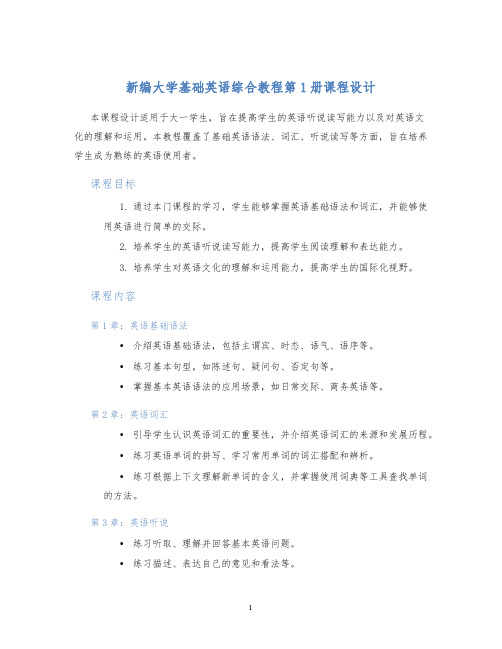
新编大学基础英语综合教程第1册课程设计本课程设计适用于大一学生,旨在提高学生的英语听说读写能力以及对英语文化的理解和运用。
本教程覆盖了基础英语语法、词汇、听说读写等方面,旨在培养学生成为熟练的英语使用者。
课程目标1.通过本门课程的学习,学生能够掌握英语基础语法和词汇,并能够使用英语进行简单的交际。
2.培养学生的英语听说读写能力,提高学生阅读理解和表达能力。
3.培养学生对英语文化的理解和运用能力,提高学生的国际化视野。
课程内容第1章:英语基础语法•介绍英语基础语法,包括主谓宾、时态、语气、语序等。
•练习基本句型,如陈述句、疑问句、否定句等。
•掌握基本英语语法的应用场景,如日常交际、商务英语等。
第2章:英语词汇•引导学生认识英语词汇的重要性,并介绍英语词汇的来源和发展历程。
•练习英语单词的拼写、学习常用单词的词汇搭配和辨析。
•练习根据上下文理解新单词的含义,并掌握使用词典等工具查找单词的方法。
第3章:英语听说•练习听取、理解并回答基本英语问题。
•练习描述、表达自己的意见和看法等。
•练习不同语音语调的模仿,提高听说的流利度。
第4章:英语阅读•练习阅读英语短文、新闻等,理解文章的主题、大意和细节。
•掌握阅读技巧,如寻找关键词、预测文章内容、注意上下文等。
•练习根据文章内容回答问题,培养学生的阅读理解能力。
第5章:英语写作•练习英语写作技巧,包括句型、段落结构和语法等。
•练习表达自己的思想和观点,如写作日记、个人陈述等。
•练习写作常见类型文章,如求职信、邀请信等。
教学方法本课程采用多种教学方法,包括听讲、阅读、写作、讨论、演讲等。
教师将会提供丰富的教学材料,如教科书、音频、视频、练习册,通过交互式教学,培养学生的英语听说读写能力。
评估方式学生的学习成果将通过考试、练习、作业等方式进行评估。
具体评估方式包括:1.阅读理解测试:检测学生阅读理解能力,学生需要根据文章回答相关问题。
2.语音语调测试:测试学生的语音语调模仿能力,学生需要模仿不同语音语调。
全新版大学综合教程1电子教案unit2

全新版大学综合教程1 Unit 2二、教学目的1. 理解并掌握本单元的核心词汇和短语。
2. 通过阅读、听力、口语和写作等实践活动,提高学生的英语综合运用能力。
3. 培养学生的跨文化交际意识,了解不同文化背景下的生活习惯和思维方式。
三、课型新授课四、课时2课时五、教学重点1. 核心词汇和短语的理解与运用。
2. 阅读理解能力。
3. 听力理解能力。
4. 口语表达和写作能力。
六、教学难点1. 理解并运用本单元的核心词汇和短语。
2. 提高阅读速度和准确性,掌握阅读技巧。
3. 在听力过程中捕捉关键信息,提高听力理解能力。
4. 在口语表达和写作中运用正确的语法和词汇,表达清晰、流畅。
七、教学过程(一)导入新课1. 教师简要介绍本单元的主题和内容,激发学生的学习兴趣。
2. 学生自由讨论,分享自己对相关话题的看法和经验。
(二)讲授新课1. 阅读理解(1)教师引导学生快速浏览文章,了解文章大意。
(2)学生分组讨论,分析文章结构、段落大意和关键信息。
(3)教师总结,讲解文章中的难句和重点词汇。
2. 听力理解(1)教师播放听力材料,学生听后回答问题。
(2)教师讲解听力技巧,指导学生如何捕捉关键信息。
(3)学生分组讨论,分享听力感受和收获。
3. 口语表达(1)教师引导学生围绕本单元主题进行口语练习。
(2)学生分组进行角色扮演,模拟真实场景。
(3)教师点评,指导学生如何提高口语表达能力。
4. 写作(1)教师讲解写作技巧,指导学生如何组织文章结构。
(2)学生根据教师提供的写作框架,完成写作任务。
(3)教师点评,指导学生如何提高写作能力。
(三)巩固练习1. 学生完成课后练习,巩固所学知识。
2. 教师选取部分练习进行讲解,帮助学生解决疑难问题。
(四)归纳小结1. 教师总结本单元所学内容,强调重点和难点。
2. 学生回顾所学知识,分享学习心得。
(五)作业布置1. 学生预习下一单元内容,为下一节课做好准备。
2. 完成课后练习,巩固所学知识。
新编大学英语综合教程教案

课时:2课时教学目标:1. 知识目标:(1)掌握本单元的词汇和短语;(2)了解本单元的语法知识,如现在进行时、过去进行时等;(3)提高学生的阅读理解能力。
2. 能力目标:(1)培养学生运用英语进行口语表达的能力;(2)提高学生的听力理解能力;(3)提高学生的写作能力。
教学重点:1. 词汇和短语;2. 语法知识;3. 阅读理解。
教学难点:1. 词汇和短语的运用;2. 语法知识的理解和运用;3. 阅读理解的技巧。
教学过程:第一课时一、导入1. 通过提问学生:“Do you remember your first day at school?”引导学生回忆自己的第一天上学经历,激发学生的兴趣。
2. 向学生介绍本单元的主题:My First Day at School。
二、词汇教学1. 利用PPT展示本单元的词汇,引导学生朗读并记忆。
2. 结合例句,让学生理解词汇的含义和用法。
3. 进行词汇练习,巩固所学词汇。
三、语法教学1. 介绍本单元的语法知识:现在进行时、过去进行时。
2. 通过例句讲解语法知识,让学生理解其用法。
3. 进行语法练习,巩固所学语法知识。
四、阅读教学1. 题目:My First Day at School2. 学生阅读课文,了解文章大意。
3. 提问检查学生对文章的理解。
4. 引导学生分析文章的结构和写作手法。
五、口语教学1. 学生分角色朗读课文,练习口语表达。
2. 针对课文内容,进行口语练习,如:复述课文、回答问题等。
第二课时一、复习1. 回顾上一节课所学的词汇和语法知识。
2. 进行词汇和语法练习,巩固所学知识。
二、听力教学1. 播放听力材料,让学生听取关于第一天上学的经历。
2. 学生回答问题,检查听力理解能力。
3. 分析听力材料,总结听力技巧。
三、写作教学1. 学生根据课文内容,写一篇关于自己第一天上学的短文。
2. 学生互相批改作文,互相学习。
3. 教师点评作文,指出优点和不足。
四、总结1. 回顾本单元所学内容,强调重点和难点。
大学英语综合教程1unit6教案

课时:2课时教学目标:1. 通过本单元的学习,学生能够掌握与主题相关的词汇和短语。
2. 学生能够理解并运用本单元中的语法知识。
3. 学生能够提高阅读、听力、口语和写作能力。
教学重点:1. 词汇和短语:掌握与主题相关的词汇和短语。
2. 语法知识:掌握时态、语态等语法知识。
3. 语言技能:提高阅读、听力、口语和写作能力。
教学难点:1. 词汇和短语:掌握与主题相关的难词和短语。
2. 语法知识:正确运用时态、语态等语法知识。
3. 语言技能:提高学生的综合语言运用能力。
教学准备:1. 教材:《大学英语综合教程1》2. 多媒体课件3. 教学参考书教学过程:第一课时一、导入1. 教师用英语简短介绍本单元的主题,激发学生的学习兴趣。
2. 学生自由讨论与本单元主题相关的话题。
二、词汇和短语学习1. 教师带领学生朗读并讲解本单元的词汇和短语。
2. 学生跟读,并尝试用所学词汇和短语进行造句。
三、语法知识讲解1. 教师讲解本单元的语法知识,如时态、语态等。
2. 学生跟读并练习运用所学语法知识。
四、阅读练习1. 教师指导学生阅读课文,并提出相关问题。
2. 学生回答问题,教师点评并纠正错误。
五、总结1. 教师对本节课的学习内容进行总结。
2. 学生复述本节课所学知识。
第二课时一、复习1. 教师提问,检查学生对上节课学习内容的掌握情况。
2. 学生回答问题,教师点评并纠正错误。
二、听力练习1. 教师播放听力材料,学生听后回答相关问题。
2. 教师点评并纠正错误。
三、口语练习1. 教师组织学生进行口语活动,如角色扮演、小组讨论等。
2. 学生积极参与,教师点评并纠正错误。
四、写作练习1. 教师布置写作任务,学生根据所学知识进行写作。
2. 教师点评学生作文,指出优点和不足。
五、总结1. 教师对本节课的学习内容进行总结。
2. 学生复述本节课所学知识。
教学反思:本节课通过多种教学活动,帮助学生掌握本单元的词汇、短语和语法知识,提高学生的阅读、听力、口语和写作能力。
新编大学英语第一册教案

Unit 1 Personal Relationships1. Preparation (Period 1& 2)Background InformationAll of us are involved in personal relationships. Some of these are related to family, some with fellow students or workers, and others of a variety of types. Most of these are happy, positive relationships, but not all of them. To have a positive relationship a person must invest time and interest in the other persons with whom he is associated. We all understand that our feelings and interest in other persons depend somewhat on what we have in common. Good relationships are usually valued because people who have good relationships are happier and more fun to be with.1.1 What kinds of relationship are you involved everyday?Can you complete the pairs of words about personal relationships?parent —host —husband —boyfriend —teacher —clerk —doctor —driver —employer —buyer —writer —performer —lawyer —director —policeman —interviewer —Eg: twins, family, couple, cousin, sisters, colleagues, leaders and audiencesisters and brothers, lovers, friends, neighbors, colleagues, schoolmates, fellow workers,…Are they important for your daily life or study? Why? List one example and explain it.1.2 Of all the relationships, which one do you think is easier to be established at the beginning of your college life? Why?A StoryListen to a short story and complete the following sentences:1. The story took place at the time of ______________________________________.2. The relationship between the woman and the little boy is _________.3. The woman led the little boy into the store because ______________________________.4. The woman bought the boy______________________________.5. ―Are you God…‖ here means ____________.原文:They came back outside into the street and the woman said to the child, ―Now you can go home and have a very happy holiday.‖ The little boy looked up at her and asked, ―Are you God, Ma’am?‖ She smiled down at him and replied, ―No, son, I’m just one of his children.‖ The little boy then said, ―I knew you had to be a relative of God.‖Welcome to Our Group!Introducing Yourself to Your Group Members Locationprovince 省 city 市county 县town 镇village 村in the suburbs of 在…的郊区high/middle school 中学key high school 重点中学high school attached to附属中学Personalityfrank 坦率的honest 诚实的outgoing 外向的shy 胆怯的introverted 内向的enthusiastic 热情的Hobbiesstamp-collecting 集邮 sports 运动reading 阅读watching TV 看电视 drawing 绘画photography 摄影 calligraphy 书法traveling 旅游shopping 购物surfing the net 网上冲浪playing cards 打牌fishing 钓鱼like 喜欢be keen on 喜爱prefer 比较喜欢favorite 最爱dislike 不喜欢Discussion in Pairs1. What is your viewpoint of the interpersonal relationships nowadays?2. If you were the woman, what would you do? Try to explain it.3. In our life, some people are open while some others are reserved. Which type do you prefer? Why?Listen to a passage and answer questions:acquaintance 熟人intimate 亲密的harmonious 和谐的t olerate 容忍Questions :1. According to the passage, what is the word ―friend‖?It covers a wide range of meanings as a classmate, a nodding acquaintance, a coworker, etc. 2. Why does everyone need friendship?We need help from, and also give help to, others.3. Why do modern people attach more importance to friendship?As life is full of difficulties and conflict, we need friends to support and help us and give us warnings against danger.原文We Need FriendsThe word, ―friend‖, covers a wide range of meanings. It can be a nodding acquaintance, a classmate, a partner, a playmate, or an intimate colleague. Everyone needs friendship. No one can sail the ocean of life single-handed. We need help from, and also give help to, others. In modern times, people attach more importance to relationships and connections. As life is full of difficulties and conflict, we need friends to support and help us. Our friends give us warnings against danger. Our friends offer us advice with regard to how to deal with various situations.Proverbs and SayingsA friend in need is a friend indeed.A friend is best found in adversity.患难见真情。
新编大学英语综合教程第一册unit1教学案(附答案)

Unit 1Personal RelationshipIn-Class Reading The Gift of Life以生命相赠1 炸弹落在了这个小村庄里。
在可怕的越南战争期间,谁也不知道这些炸弹要轰炸什么目标,而它们却落在了一所由传教士办的小孤儿院内。
2 传教士和一两个孩子已经丧生,还有几个孩子受了伤,其中有一个小女孩,8岁左右,双腿被炸伤了。
3 几小时后,医疗救援小组到了。
医疗小组由一名年轻的美国海军医生和一名同样年轻的海军护士组成。
他们很快发现有个小女孩伤势严重。
显然,如果不立即采取行动,她就会因失血过多和休克而死亡。
4 他们明白必须给小女孩输血,但是他们的医药用品很有限,没有血浆,因此需要匹配的血型。
快速的血型测定显示两名美国人的血型都不合适。
而几个没有受伤的孤儿却有匹配的血型。
5 医生会讲一点越南语,护士会讲一点法语,但只有中学的法语水平。
孩子们不会说英语,只会说一点法语。
医生和护士用少得可怜的一点共同语言,结合大量的手势,努力向这些受惊吓的孩子们解释说,除非他们能输一些血给自己的小伙伴,否则她将必死无疑。
然后他们问孩子们是否有人愿意献血来救小女孩。
6 对医生和护士的请求,孩子们瞪大眼睛,一声不吭。
此时小病人生命垂危。
然而,只有这些受惊吓的孩子中有人自愿献血,他们才能够得到血。
过了好一会儿,一只小手慢慢地举了起来,然后垂了下去,一会儿又举了起来。
7 “噢,谢谢,”护士用法语说。
“你叫什么名字?”8 “兴,”小男孩回答道。
9 兴很快被抱到一张床上,手臂用酒精消毒后,针就扎了进去。
在整个过程中,兴僵直地躺着,没有出声。
10 过了一会儿,他发出了一声长长的抽泣,但立即用那只可以活动的手捂住了自己的脸。
11 “兴,疼吗?”医生问。
12 兴默默地摇了摇头,但一会儿忍不住又抽泣起来,并又一次试图掩饰自己的哭声。
医生又问是不是插在手臂上的针弄疼了他,兴还是摇了摇头。
13 但现在,偶尔的抽泣变成了持续无声的哭泣。
大学英语综合教程1教案
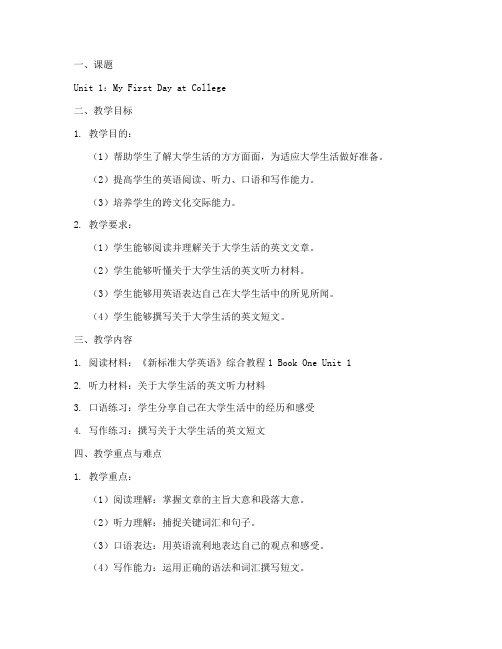
一、课题Unit 1:My First Day at College二、教学目标1. 教学目的:(1)帮助学生了解大学生活的方方面面,为适应大学生活做好准备。
(2)提高学生的英语阅读、听力、口语和写作能力。
(3)培养学生的跨文化交际能力。
2. 教学要求:(1)学生能够阅读并理解关于大学生活的英文文章。
(2)学生能够听懂关于大学生活的英文听力材料。
(3)学生能够用英语表达自己在大学生活中的所见所闻。
(4)学生能够撰写关于大学生活的英文短文。
三、教学内容1. 阅读材料:《新标准大学英语》综合教程1 Book One Unit 12. 听力材料:关于大学生活的英文听力材料3. 口语练习:学生分享自己在大学生活中的经历和感受4. 写作练习:撰写关于大学生活的英文短文四、教学重点与难点1. 教学重点:(1)阅读理解:掌握文章的主旨大意和段落大意。
(2)听力理解:捕捉关键词汇和句子。
(3)口语表达:用英语流利地表达自己的观点和感受。
(4)写作能力:运用正确的语法和词汇撰写短文。
2. 教学难点:(1)词汇理解:掌握与大学生活相关的词汇。
(2)语法运用:正确运用英语语法知识。
(3)跨文化交际:了解西方文化背景,提高跨文化交际能力。
五、教学过程1. 导入新课(1)教师简要介绍大学生活的相关背景,激发学生的学习兴趣。
(2)提问:学生对自己大学生活有什么期待?2. 阅读教学(1)学生阅读课文,了解文章主旨大意。
(2)教师讲解文章中的生词、短语和语法结构。
(3)学生分组讨论,分享阅读心得。
3. 听力教学(1)学生听关于大学生活的英文听力材料,捕捉关键词汇和句子。
(2)教师总结听力材料中的主要内容,并引导学生进行复述。
4. 口语练习(1)学生分组讨论,分享自己在大学生活中的经历和感受。
(2)教师鼓励学生用英语表达自己的观点,并给予适当的评价和指导。
5. 写作教学(1)学生根据课文内容,撰写关于大学生活的英文短文。
(2)教师批改作文,指出学生的优点和不足,并进行针对性指导。
新编大学基础英语综合教程第一册教案
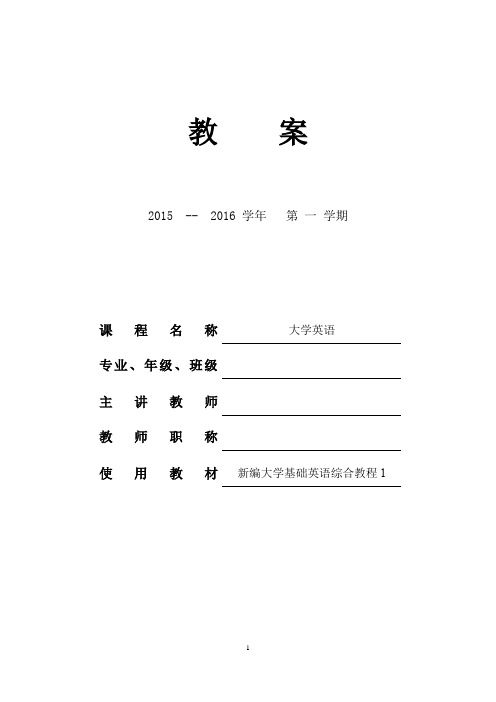
教学方式、手段、媒介:
教学方式(Teaching method):
1. lecture
2. role play
讨论、思考题、作业:
1. Organize the students into groups to complete theinformationfor your group members as well as yourself, which may include:
Then ask one student from each group to report the results of their interview.
efulExpressions:*
1) at a wedding
2) at a disco
3) on holiday
4) be/come from
5) hi, there
6) date of birth
7) in lower case
8) in capitals
2. Language Focus on?
Reading
Understand short texts describing jobs and morning routines and read a snack bar menu.
Language quality
Use determiners and possessive pronouns, the Present Simple.
2. Assign the exercise after the text.
《全新版大学英语综合教程》第1册教案
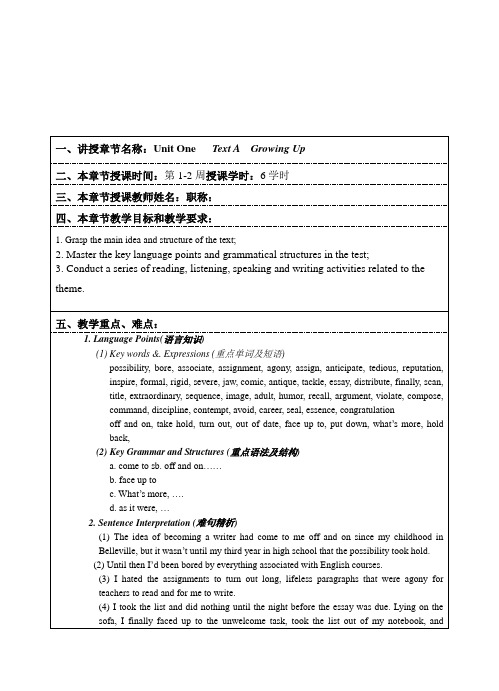
Section B.(略讲)
一、讲授章节名称:Unit TwoTextA. Friendship
二、本章节授课时间:第3-4周授课学时:6学时
三、本章节授课教师姓名:职称:
四、本章节教学目标和教学要求:
1. Grasp the main idea and structure of the text;
be lost in/lose oneself in, orsomething, go head, know/learn by heart, might/may (just) as well, not much of a, keep up, all the way, kind/sort of, lose touch, a couple of, on one’s mind, keepin touch(with), come up, go by, hang out, every now and then, choke up, in the distance, right awa
possibility, bore, associate, assignment, agony, assign, anticipate, tedious, reputation, inspire, formal, rigid, severe, jaw, comic, antique, tackle, essay,distribute, finally, scan, title,extraordinary, sequence, image, adult, humor, recall, argument, violate, compose, command,discipline, contempt, avoid, career, seal, essence, congratulation
新编英语教程1第三版教学设计
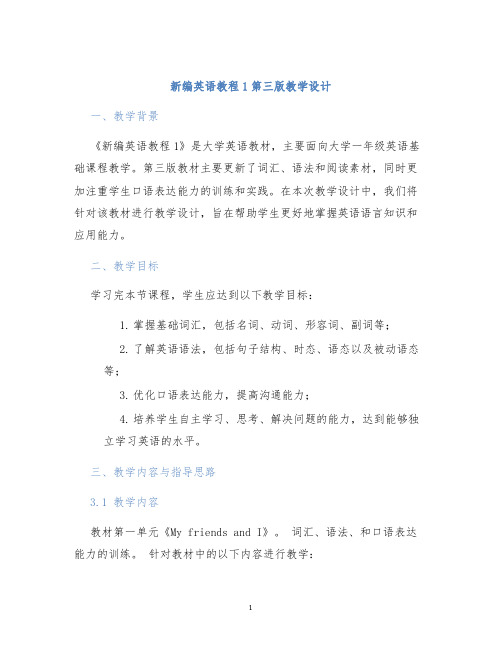
新编英语教程1第三版教学设计一、教学背景《新编英语教程1》是大学英语教材,主要面向大学一年级英语基础课程教学。
第三版教材主要更新了词汇、语法和阅读素材,同时更加注重学生口语表达能力的训练和实践。
在本次教学设计中,我们将针对该教材进行教学设计,旨在帮助学生更好地掌握英语语言知识和应用能力。
二、教学目标学习完本节课程,学生应达到以下教学目标:1.掌握基础词汇,包括名词、动词、形容词、副词等;2.了解英语语法,包括句子结构、时态、语态以及被动语态等;3.优化口语表达能力,提高沟通能力;4.培养学生自主学习、思考、解决问题的能力,达到能够独立学习英语的水平。
三、教学内容与指导思路3.1 教学内容教材第一单元《My friends and I》。
词汇、语法、和口语表达能力的训练。
针对教材中的以下内容进行教学:1.人称代词和物主代词的使用;2.简单时态(现在时、过去时以及将来时)的使用;3.动词的被动语态;4.多种句子结构的使用;5.常用的日常英语口语表达。
通过多种学习方式,全面提高学生英语语言综合素养和应用能力,达到英语语言沟通的基本要求。
3.2 指导思路1.提高学生的学习兴趣,增强学习主动性和积极性。
通过小组讨论、课堂问答、真实场景模拟等方式,让学生感知英语语言的巨大魅力,提高主动学习的意识。
2.基于学生的实际掌握水平,采用多种教学手段。
无论是针对词汇的阅读训练、语法知识的梳理与模拟训练,还是口语交际能力的提升,本次教学肯定有多种形式的练习活动。
3.系统性地传授英语语言知识,严格把关学习效果。
逐步推进解题思路,梳理重点难点知识体系,切实提高学生英语语言的全面分析及解决问题的能力。
三、教学过程3.1 教学方法采用多种教学方法:1.讲授;2.互动交流;3.问答;4.课外练习。
3.2 教学流程第一步:引入通过一些真实的英语场景让学生感受到英语语言实际应用的价值。
第二步:阅读理解通过阅读教材,让学生掌握重要词汇和英语语言的基础语法知识,并通过练习巩固记忆。
新编大学基础英语综合教程第一册教案

新编⼤学基础英语综合教程第⼀册教案本科课程教案2017-2018 学年(第 1 学期)课程名称:⼤学英语CI课程性质:□通识必修课□⼤类基础课□专业核⼼课□专业拓展课□通识限选课□通识任选课授课班级:17产品设计1班(32⼈)、环境设计七班(30⼈)学⽣数:共62⼈授课教师:庞海才学分/学时:6/75学时分配:理论讲授学时,课堂讨论学时实验/课内实践学时,在线学习学时课程设计(周)系(教研室)负责⼈(签名):主管教学院长(签名):审核通过⽇期:年⽉⽇Unit 4 What’s On?I.教学⽬标ObjectivesStudents will be able to:Talk about free time activitiesMatch descriptions to photosIntroduce and practise the use of the -ing verb form after go, like and love Use expressions of frequency to talk about habits in a quizII. 课时安排Time Allotment(体现重点、难点)1st period:Lesson 1)2nd period: Lesson 23rd period: Lesson 34th period: Lesson 4III. 教学⽅法与⼿段Teaching MethodologyStudent-centered approachStudent-centered learning requires students to be active, responsible participants in their own learning. Instead of lecturing through the whole class, the teacher t akes students interests into account, follows their passions, capitalizes on their strengths and helps students form a strong learning community.Task-based approachThe main aim of this approach to learning is task completion. Usually, relevant and interesting tasks are set by the teacher and students are expected to draw on their pre-existing knowledge of English to complete the task.IV. 教学内容及过程Tasks and ProcessLesson 1 Time OutLexical PreparationVocabulary &Listening1. Work in pairs. Find phrases to describe the photos below.Key:a. I go swimming.b. We go to concerts.c. We go rollerblading on the seafront.d. I sit in a café and read the paper.e. We spend hours playing computer games.f. I work out in the gym.2. Work in pairs. Look at the above list and ask your partner: What do you do in your freetime?3. Listen to Nikki and Martin answering the same questions. Tick the activities they mention.4.Listen again. Match the answers to the questions and write the name of the person who’s speaking (Nikki or Martin). Questions:1. What do you do in your free time?2. What do you like doing on Sundays?3. How often do you go to concerts / the cinema?Lesson 2 Going OutSpeaking1. Work in pairs. Match the questions with the answers.2. Ask your classmates the questions. Find the person who is most similar to you.Listening1. Listen to a telephone conversation and answer the questions.1. Are the two people friends?a) yes b) no2. Where is the woman?a) at home b) in the office c) in the street3. Is she busy?a) yes b) no4. Why does the man phone the woman?a) to talk about workb) to invite her for a drinkc) to ask for help2. Match the questions and the answers.1. Are you busy? a) I’m visiting some friends.2. What are you doing? b) I’m in the office.3. What are you doing here? c) I’m writing a report.Listen and check.Practice4. Listen to their mobile phone conversations. Are they telling the truth?Conversation 1 Conversation 2Conversation 3 Conversation 45. Complete the dialogue. Listen and check.1. A: Hi, ______ you working?B: No, I _______. ______ having a drink with a friend .What ______ you doing? Are you busy?A: No, I _______.B: Well, come and have a drink with us!2. C: Hi, ______ you watching the football?D: Yes, I ______. ______ watching it with some friends in the pub.C: _______ Rob watching it with you?D: No, he _______. He’ s doing some work at home.6. Match the dialogues with two of the photos.7. Work in pairs. Write similar dialogues for the other two photos. Practise reading them with your partner.8. Translate the following sentences into English.1. 玛丽亚的母亲正在打扫客厅Maria’s mother is cleaning the sitting room.2. —孩⼦们在做作业吗?—不, 他们在踢⾜球。
新编大学英语第一册教案

课时安排:2课时教学目标:1. 培养学生的英语阅读能力,提高阅读速度和理解力。
2. 扩大学生词汇量,掌握基本语法知识。
3. 培养学生的英语口语表达能力和听力理解能力。
4. 增强学生的英语写作能力,提高书面表达能力。
教学内容:1. 单元主题:日常生活中的英语表达2. 课文:《日常生活中的英语表达》教学重点:1. 课文中的词汇和短语2. 课文中的语法知识3. 课文中的句型和结构4. 课文中的听力理解技巧教学难点:1. 词汇的记忆和运用2. 语法知识的理解和运用3. 听力理解的准确性教学准备:1. 课文教材2. 词汇卡片3. 语法讲解PPT4. 听力材料教学过程:第一课时:一、导入1. 利用图片或视频,展示与课文主题相关的日常生活场景,激发学生的兴趣。
2. 引导学生谈论自己在日常生活中遇到的英语表达,引出课文主题。
二、阅读1. 学生阅读课文,了解课文大意。
2. 教师讲解课文中的生词、短语和语法知识。
3. 学生跟读课文,模仿语音、语调。
三、讨论1. 教师提出与课文相关的问题,引导学生进行讨论。
2. 学生分组讨论,分享自己的观点和经验。
四、听力1. 学生听课文录音,回答相关问题。
2. 教师讲解听力技巧,提高学生的听力理解能力。
第二课时:一、复习1. 复习第一课时的内容,检查学生对课文的理解程度。
2. 学生互相提问,巩固所学知识。
二、口语1. 学生进行角色扮演,模拟课文中的场景,练习口语表达。
2. 教师给予指导和评价。
三、写作1. 学生根据课文主题,写一篇短文。
2. 教师讲解写作技巧,指导学生提高写作能力。
四、总结1. 教师总结本节课的主要内容,强调重点和难点。
2. 学生分享自己的学习心得。
教学评价:1. 学生在课堂上的参与度和表现。
2. 学生对课文内容的掌握程度。
3. 学生在口语和写作方面的进步。
教学反思:1. 根据学生的学习情况,调整教学内容和方法。
2. 关注学生的学习需求,提高教学效果。
新通用大学英语综合教程第1册教学设计
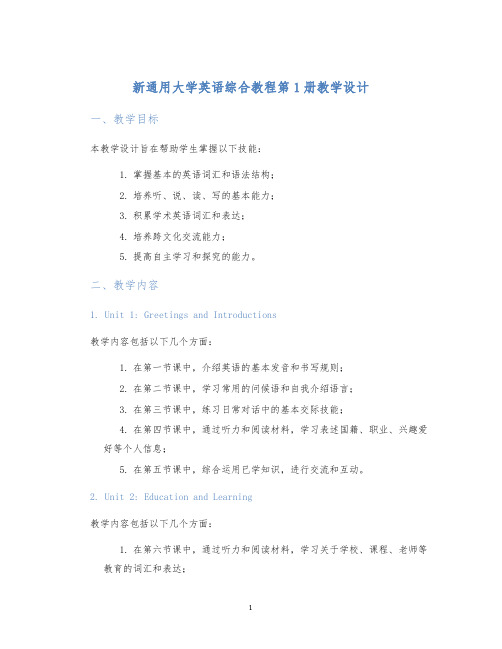
新通用大学英语综合教程第1册教学设计一、教学目标本教学设计旨在帮助学生掌握以下技能:1.掌握基本的英语词汇和语法结构;2.培养听、说、读、写的基本能力;3.积累学术英语词汇和表达;4.培养跨文化交流能力;5.提高自主学习和探究的能力。
二、教学内容1. Unit 1: Greetings and Introductions教学内容包括以下几个方面:1.在第一节课中,介绍英语的基本发音和书写规则;2.在第二节课中,学习常用的问候语和自我介绍语言;3.在第三节课中,练习日常对话中的基本交际技能;4.在第四节课中,通过听力和阅读材料,学习表述国籍、职业、兴趣爱好等个人信息;5.在第五节课中,综合运用已学知识,进行交流和互动。
2. Unit 2: Education and Learning教学内容包括以下几个方面:1.在第六节课中,通过听力和阅读材料,学习关于学校、课程、老师等教育的词汇和表达;2.在第七节课中,练习围绕教育话题进行交流;3.在第八节课中,通过听力和阅读材料,学习描述学习和学术的词汇和表达;4.在第九节课中,练习如何写好一篇英文作文,包括提纲、立意和语言表达;5.在第十节课中,通过阅读名人传记,了解优秀人物励志故事,培养学生的人文素养和文化兴趣。
三、教学方法为了达到预期的教学目标,本课程将采用多种教学方法与形式,包括:1.听说读写训练:鼓励学生多听多说,多读多写,提高英语综合应用能力;2.小组讨论:利用小组互动的方式,深入交流和思考话题;3.视听材料学习:通过看电影、听音乐等形式,扩大学生的语言视野和文化知识;4.分组演讲:培养学生口头表达能力和团队合作精神;5.阅读作业:通过阅读名人传记等材料,提升学生的阅读理解和文化素养。
四、教学评价为了实现教学质量的有效评估,本课程采取以下评价方式:1.出席率:考勤管理,要求学生至少出席80%的课程;2.作业完成率:平时布置有关听力、阅读、口头表达和写作的作业,要求学生完成并及时提交;3.组内评价和反馈:要求学生在小组内相互评价和反馈,提高学生对自己和互动团队的认识和实际表现;4.总评成绩:期末考试将占总成绩60%的比重,平时成绩占40%的比重,最终分数按照等级制公布。
《综合英语(第一册)》电子教案Unit1Collegelife
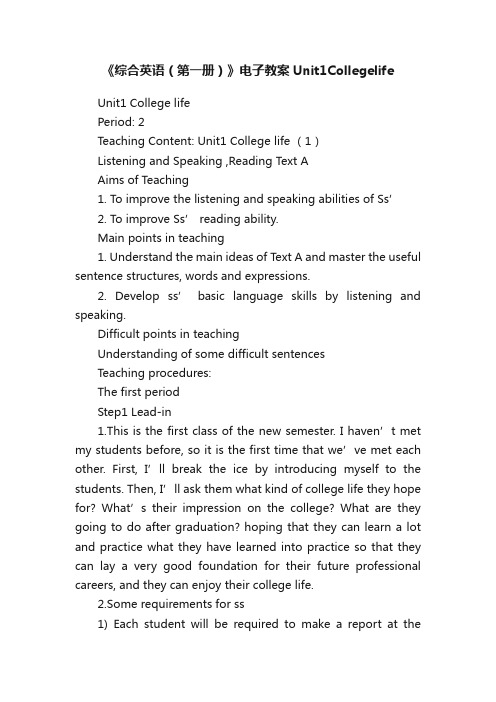
《综合英语(第一册)》电子教案Unit1CollegelifeUnit1 College lifePeriod: 2Teaching Content: Unit1 College life (1)Listening and Speaking ,Reading Text AAims of Teaching1. To improve the listening and speaking abilities of Ss’2. To improve Ss’ reading ability.Main points in teaching1. Understand the main ideas of Text A and master the useful sentence structures, words and expressions.2. Develop ss’ basic language skills by listening and speaking.Difficult points in teachingUnderstanding of some difficult sentencesTeaching procedures:The first periodStep1 Lead-in1.This is the first class of the new semester. I haven’t met my students before, so it is the first time that we’ve met each other. First, I’ll break the ice by introducing myself to the students. Then, I’ll ask them what kind of college life they hope for? What’s their impression on the college? What are they going to do after graduation? hoping that they can learn a lot and practice what they have learned into practice so that they can lay a very good foundation for their future professional careers, and they can enjoy their college life.2.Some requirements for ss1) Each student will be required to make a report at thebeginning of class2) All students are divided into 10 learning groups, with 4 students a group and a group reader will be chosen by themselves3. Tips on how to learn English well at collegeStep2 Listening1. Activity 1 Sound Recognition2. Activity 2 Conversation3. Activity 3 PassageQuestions and Answers1. Q: What is the weather like in Britain?A: It is cool in summer and warm in winter.2. Q: When do the winds bring cool air to Britain?A: In summer.3. Q: Why isn’t there much difference between the summer and winter weather?A: Because the winds from the west blow Britain all the year.4. Q: In which part of Britain is there less rain?A: In the east.5. Q: What is the passage mainly talk about?A: The weather in Britain.Step3 SpeakingThis activity mainly focuses on going over some useful expressions, and how to use them in a real dialog1. Activity 1A: Good morning, Wang Xiaoping.B: Good morning, Huang Linwei.A: How are you this week?B: Just fine. Thank you. And you?A: I’m fine, too. Thank you.A: Hello, Jane.B: Hello, David.A: How are you doing these days?B: Fine, thanks. How about you?A: I’m fine, too. Thank you.B: Is Grace well now?A: She is very well. She is now in China.B: That’s good.The second periodStep4: DiscussionWhat kind of college students do you expect to be?S1:Before I entered the college, I had a dream that I could become the top student in my class. When I woke up, I was determined that I should try my best to make my dream come true. So now I study very hard, and I am sure that my dream will come true some day.S2:After I came to the college, I think that I should develop myself in every field. First, I should study well, and then I should take most of the students’ activities if I am free. I hope that I can become the chairma n of the students’ union of our college, because I can have more chances for practice. In that way, I can learn much more.S3:I hope that I can study well at college. For example, I can read a lot of books, learn a lot from my teachers and classmates, pass every examination and become one of the top students in my class.S4:I hope that I can fully develop myself. First, I can learn as much as I can and pass all the examinations easily. Then, I can make a lot of friends on and off campus so that I can easily get a job after my graduation.Step 5: Fast reading1 Ask ss to read Text A as fast as they can and get the general idea of the passage. Then finish the “reading comprehension” on p82. Close books and concentrate on the recording of Text A3. Read the text aloudStep6 Homework1. Recite the new words on Text A and understand Text A2. Finish off Exs on p10-13。
大学基础英语1教案

教学对象:大学一年级新生教学目标:1. 掌握基本的英语问候语和自我介绍的表达方式。
2. 能够在简单的社交场合进行基本的交流。
3. 培养学生对英语学习的兴趣,提高学习积极性。
教学重点:- 英语问候语的用法- 自我介绍的常用句型- 简单社交场合的交流技巧教学难点:- 正确发音和语调- 在实际交流中灵活运用所学句型教学方法:- 任务型教学- 小组讨论- 角色扮演- 互动练习教学准备:- 教材:《新编大学基础英语》第1册- 多媒体课件- 录音设备- 小组讨论材料教学过程:第一课时1. 导入(5分钟)- 教师用英语进行自我介绍,并询问学生是否愿意用英语进行简单的自我介绍。
- 引导学生思考:在社交场合,如何用英语进行问候和自我介绍?2. 新授(25分钟)- 教师展示多媒体课件,讲解英语问候语的用法,如“Goodmorning/afternoon/evening”、“Hello”等。
- 教师示范自我介绍的常用句型,如“Nice to meet you. My name is...”等。
- 学生跟读并模仿。
3. 练习(15分钟)- 学生两人一组,互相练习问候和自我介绍。
- 教师巡视指导,纠正发音和语调。
4. 角色扮演(10分钟)- 学生分组进行角色扮演,模拟在社交场合进行问候和自我介绍的场景。
- 教师点评并给予指导。
第二课时1. 复习(5分钟)- 教师带领学生复习上一节课学到的问候语和自我介绍句型。
2. 拓展(15分钟)- 教师展示多媒体课件,讲解更多实用的社交场合英语表达,如询问对方姓名、职业等。
- 学生跟读并模仿。
3. 小组讨论(10分钟)- 学生四人一组,讨论在社交场合如何用英语进行交流。
- 教师巡视指导,鼓励学生积极参与讨论。
4. 总结(5分钟)- 教师总结本节课的学习内容,强调英语问候语和自我介绍的重要性。
- 鼓励学生在日常生活中多使用英语进行交流。
课后作业:1. 用英语写一篇自我介绍,内容包括姓名、年龄、专业等。
全新版大学英语1电子教案

课程名称:大学英语综合教程1授课时间:第1课时教学目标:1. 让学生掌握本课的基本词汇和语法知识。
2. 培养学生的阅读理解能力、听说能力和写作能力。
3. 培养学生的跨文化交际意识。
教学内容:1. 词汇:掌握本课出现的生词和短语。
2. 语法:复习和巩固一般现在时、一般过去时、一般将来时等时态。
3. 阅读理解:通过阅读短文,提高学生的阅读速度和理解能力。
4. 听力理解:通过听力练习,提高学生的听力水平。
5. 口语表达:通过课堂讨论和角色扮演,提高学生的口语表达能力。
6. 写作:完成一篇与课文主题相关的短文。
教学过程:一、导入新课1. 通过提问学生关于英语学习的看法,激发学生的学习兴趣。
2. 引导学生回顾上一节课所学内容,为新课做好铺垫。
二、词汇教学1. 展示本课生词和短语,让学生自主朗读并解释其意思。
2. 通过例句和游戏,让学生熟练运用本课词汇。
三、语法教学1. 复习和巩固一般现在时、一般过去时、一般将来时等时态。
2. 通过例句和练习,让学生掌握时态的正确运用。
四、阅读理解1. 让学生阅读短文,并回答问题,检验学生的阅读理解能力。
2. 引导学生分析短文的结构和写作手法。
五、听力理解1. 播放听力材料,让学生听并回答问题。
2. 分析听力材料,提高学生的听力水平。
六、口语表达1. 通过课堂讨论,让学生发表自己的观点。
2. 通过角色扮演,提高学生的口语表达能力。
七、写作1. 分析写作要求,让学生明确写作方向。
2. 通过小组讨论,让学生互相交流写作思路。
3. 指导学生完成短文写作。
八、归纳小结1. 总结本课所学内容,帮助学生巩固知识。
2. 引导学生思考如何将所学知识应用到实际生活中。
九、作业布置1. 完成本课的课后练习。
2. 预习下一节课的内容。
教学评价:1. 通过课堂提问、练习和作业,评价学生的学习效果。
2. 关注学生的口语表达和写作能力,给予及时指导和反馈。
教学反思:1. 根据学生的学习情况,调整教学策略,提高教学效果。
全新版大学英语综合教程第1册教案设计
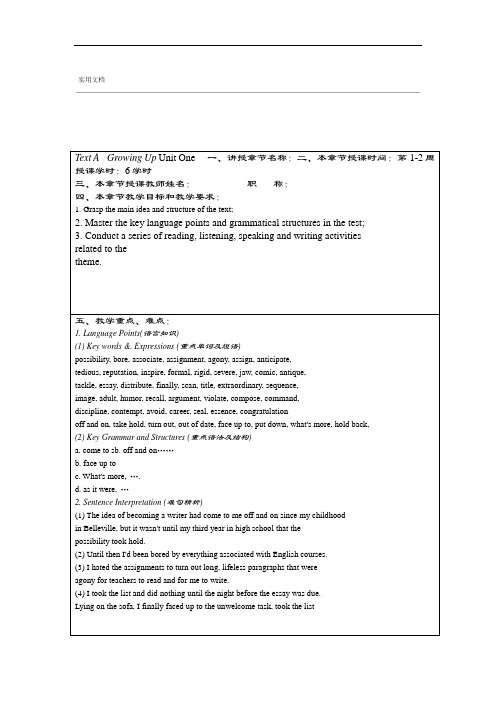
(精讲)Section A.) 15 minutes导入Step One Pre-reading Activities (Step Two While-reading Activities
) 120 minutes语言知识1. Language Points() 40 minutes难句精析2. Sentence Interpretation (Step Three Post-reading Activities 80 minutes
image, adult, humor, recall, argument, violate, compose, command,
discipline, contempt, avoid, career, seal, essence, congratulation
off and on, take hold, turn out, out of date, face up to, put down, what's more, hold back,
in Belleville, but it wasn't until my third year in high school that the
possibility took hold.
(2) Until then I'd been bored by everything associated with English courses.
3. Conduct a series of reading, listening, speaking and writing activities
related to the
theme.
五、教学重点、难点:
1. Language Points(语言知识)
- 1、下载文档前请自行甄别文档内容的完整性,平台不提供额外的编辑、内容补充、找答案等附加服务。
- 2、"仅部分预览"的文档,不可在线预览部分如存在完整性等问题,可反馈申请退款(可完整预览的文档不适用该条件!)。
- 3、如文档侵犯您的权益,请联系客服反馈,我们会尽快为您处理(人工客服工作时间:9:00-18:30)。
本科课程教案2017-2018学年(第 1 学期 )课程名称:大学英语 CI课程性质:□通识必修课□大类基础课□专业核心课□专业拓展课□通识限选课□通识任选课授课班级:17 产品设计 1 班(32 人)、环境设计七班( 30 人)学生数:共 62 人授课教师:庞海才学分 / 学时:6/75学时分配:理论讲授学时,课堂讨论学时实验 / 课内实践学时,在线学习学时课程设计( 周)系(教研室)负责人(签名):主管教学院长(签名):审核通过日期:年月日《大学英语 CI 》是教授英语语言知识和英语学习策略,培养学生外语综合应用能力和跨文化交际为主要内容的必修课,教学对象是艺术专业大一学生。
课程以外语教学理论为指导,以“课堂教学+计算机和网络的自主学习”模式为主,集多种教学模式和教学手段为一体,旨在培养学生的英语课程简介综合应用能力,尤其是听说能力;同时,提高他们的自主学习的能力和综合文化素养,以适应我国社会发展的需要和国际交流的需要。
该课程采用形成性评估和终结性评估两种形式来评估学生学习效果。
形成性评估包括课堂活动记录、课后任务记录等形式。
终结性评估包括期中测评、期末总评。
教材名称、新编大学基础英语综合教程1、 2 高等教育出版社出版社、出版新视野大学英语(第三版)视听说教程1、 2时间、版次新编大学基础英语训练与自测1、 2高等教育出版社(含中英文教材)(含参考书目、案例材料、阅读材料,网络教学资源等)新编大学基础英语训练与自测1、 2新视野大学英语(第三版)长篇阅读1、 2参考书目及文献(或网络教学资源)形成性评估:平时作业、网络学习、课堂表现、期中考试、期末考试考试考核方式(含期中考试、小测验、作业)Unit 4 What’ s On?I .教学目标 ObjectivesStudents will be able to:Talk about free time activitiesMatch descriptions to photosIntroduce and practise the use of theing- verb form after go, like andlove Use expressions of frequency to talk about habits in a quizII.课时安排 Time Allotment(体现重点、难点)1st period: Lesson 1)2nd period: Lesson 23rd period: Lesson 34th period: Lesson 4III.教学方法与手段Teaching MethodologyStudent-centered approachStudent-centered learning requires students to be active, responsible participants in their own learning. Instead of lecturing through the whole class, the teacher akest students interests into account, follows their passions, capitalizes on their strengths and helps students form a strong learning community.Task-based approachThe main aim of this approach to learning is task completion. Usually, relevant and interesting tasks are set by the teacher and students are expected to draw on their pre-existing knowledge of English to complete the task.IV. 教学内容及过程 Tasks and ProcessLesson 1Time OutLexical PreparationVocabulary &Listening1.Work in pairs. Find phrases to describe the photos below.Key:a. I go swimming.b. We go to concerts.c. We go rollerblading on the seafront.d. I sit in a caf and readé the paper.e. We spend hours playing computer games.f. I work out in the gym.2.Work in pairs. Look at the above list and ask your partner: What do you do in your freetime?3. Listen to Nikki and Martin answering the same questions. Tick the activities they mention.4.Listen again. Match the answers to the questions and write the name of the person who ’ s speaking (Nikki or Martin).Questions:1.What do you do in your free time?2.What do you like doing on Sundays?3. How often do you go to concerts / the cinema?Lesson 2Going OutSpeaking1.Work in pairs. Match the questions with the answers.2.Ask your classmates the questions. Find the person who is most similar to you. Listening1.Listen to a telephone conversation and answer the questions.1.Are the two people friends?a) yes b) no2.Where is the woman?a) at home b) in the office c) in the street3.Is she busy?a) yes b) no4.Why does the man phone the woman?a)to talk about workb)to invite her for a drinkc)to ask for help2.Match the questions and the answers.1.Are you busy?a) I ’visitingm some friends.2.What are you doing?b) I ’ m in the office.3.What are you doing here? c) I’ m writing a report.Listen and check.Practice4. Listen to their mobile phone conversations. Are they telling the truth?Conversation 1Conversation 2Conversation 3Conversation 4plete the dialogue. Listen and check.1.A: Hi, ______ you working?B:No, I _______. ______ having a drink with a friend .What ______ you doing? Are you busy?A:No, I _______.B:Well, come and have a drink with us!2.C: Hi, ______ you watching the football?D: Yes, I ______. ______ watching it with some friends in the pub.C:_______ Rob watching it with you?D:No, he _______. He ’ s doing some work at home.6.Match the dialogues with two of the photos.7.Work in pairs. Write similar dialogues for the other two photos. Practise reading them with your partner.8.Translate the following sentences into English.1.玛丽亚的母亲正在打扫客厅Maria ’ s mother is cleaning the sitting room.2.—孩子们在做作业吗 ?—不 , 他们在踢足球。
—Are the children doing their homework?—No. They are playing football.3.—露西在做什么?—她正在游泳。
—What is Lucy doing?—She is swimming.4.—你这是去哪里?—我去超市。
—Where are you going?— I ’ m going to the supermarket.5. 萨姆和他父亲正在打羽毛球。
Sam and his father are playing badminton.1.Listen and repeat. Notice the difference between the pronunciation of the twohellos.2.Listen and decide if thehello is on the phone (a) or face-to-face (b).3.Work in pairs. Practise answering the phone. Ask your partner these questions.1.Where are you?2.What are you doing?Language Focusgo, like, love + -ingplete these sentences so that they are true for you.1.I go every weekend.2.I like on Sunday.3.I love with my friends.plete these questions and then ask your partner.1. What you do at the weekend?2. What you like on Sunday?1.Read the questions and choose the best answer for you. Then ask your partner.2.Work in pairs. Ask your partner the questions in the quiz.3.What do you think your partner is? Look at the answers on page 200 and find out. Do you agree with the answers?Lesson 3At the MoviesReading1.Work in pairs. Match each film type to one of the posters.? an action film poster? a science fiction film? a love story? a thriller? a musical? a comedy2.Discuss these questions.1.What kind of films do you like?2.Have you got a favorite film? Or a favorite actor or actress?3.Do you like watching films at the cinema or do you prefer watching videos at home?4.Are there any cinemas in your town that show films in English?3.Look at these film reviews. Match each review to a film type.4.Are these sentences true? Writeyes or no.1.Double Take is about two sisters.2.Year Zero is about the past.3.The story in Roses Only Live One Dayhappens in France.4.The special effects inYear Zero are very good.5.Double Take is about a criminal.6.Roses Only Live One Dayis about an old couple.5.Answer these questions.1.Which film would you like to see?2.Which would your partner like to see?6.Translate the following sentences into English.1.我的朋友玛吉是一位性格极好的女人。
